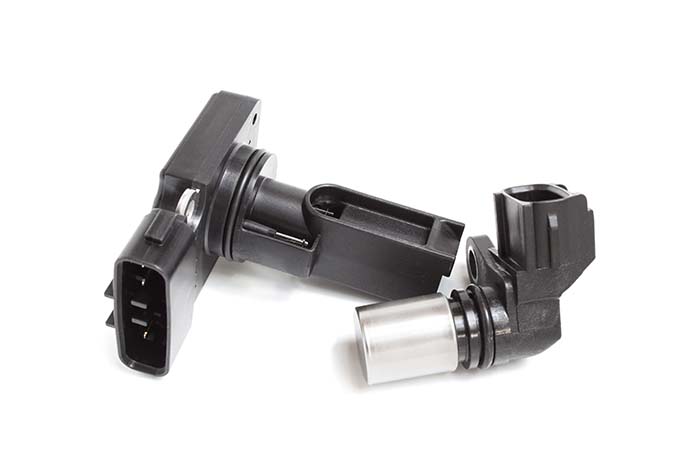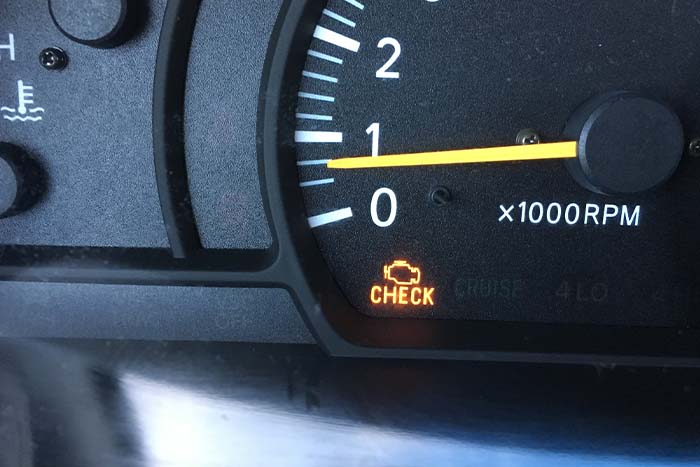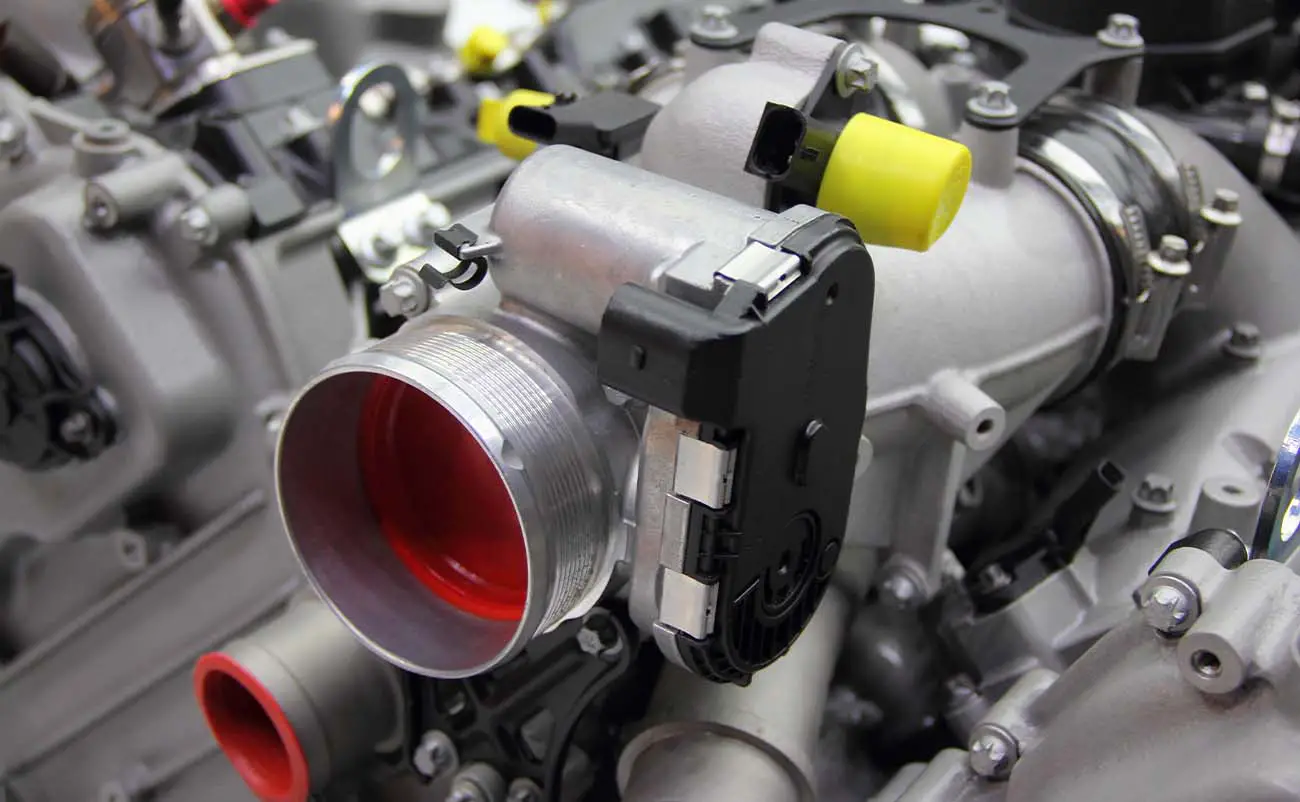You might think that pressing the gas pedal in your car is an extremely basic task. However, most modern vehicles use technology for your accelerator pedal to communicate with your car’s computer. How far you press the pedal determines how much the valve in your throttle body needs to open. The harder you press the pedal, the more the valve will open. Your throttle position sensor (TPS) measures the opening and closing of that valve. If you have a bad TPS, you might start experiencing some odd symptoms like stalling or surging. These symptoms can not only be frustrating, but they can even become dangerous at times. Keep reading to learn more about the symptoms of a faulty TPS as well as how to fix it.
Table of Contents
What Is A Throttle Position Sensor?

To help understand what a TPS is, we first need to briefly discuss how your engine operates. When you press the gas pedal, the valve on the throttle body opens wider. This allows more air into the engine, and the car’s computer knows that it should spray more fuel into the combustion chamber. In older cars, this was a mechanical process. The gas pedal had a cable that attached from the pedal to the throttle body.
In newer cars, however, technology has replaced the mechanical connector. Most vehicles today use electronic throttle control. As you press the gas, the vehicle’s electronic control module (ECM) communicates with many different parts. It reads information from the pedal about how far you have pressed it. It then uses this information to communicate with the fuel management system, which regulates both air flow and fuel.
Your throttle position sensor controls the amount of air that is allowed into the intake manifold. It determines how far open the throttle needs to be, and it communicates with a small motor and opens and closes the valve in the throttle. Problems with the sensor will allow either too much or too little air into the system, and you will start to see the symptoms described below.
Symptoms Of A Bad Throttle Position Sensor

So, how do you know when you have a failing throttle position sensor? Here are some of the most common symptoms of a bad sensor.
#1. Rough Idling
As your car idles, there should be relatively little movement in the position of the throttle. It should be slightly open, allowing in just enough air to keep the car running at an idle. However, a bad sensor might cause some wobbling in the position of the throttle. Instead of remaining still, it might open and close a small amount instead. This will cause the engine RPMs to waver instead of remaining steady. If you notice that your vehicle is idling rough, then your TPS might be to blame.
#2. Check Engine Light Illuminated
A check engine light can signal many different problems, and a bad TPS is one of those problems. Since the TPS on your vehicle controls the amount of air that enters your intake manifold, a bad sensor allows either too much or too little air. There are other sensors in the vehicle, like the mass airflow sensor, that also measure air readings. When the readings are outside the normal range, this will cause your check engine light to illuminate. You should have an automotive repair shop read the trouble codes from your ECU with a scan tool to determine whether your TPS is the cause of the warning light.
#3. Frequent Engine Stalling
This is one of the symptoms that can make your car dangerous to drive. If your TPS causes the butterfly valve in your throttle to close too much while driving, then it will cause your car engine to die. A malfunctioning TPS can also affect your car’s fuel injection system. It might not deliver enough fuel into the engine, and this can cause your vehicle to stall as well. If this situation happens frequently, then you should have a mechanic check your vehicle to determine whether your TPS sensor might be the issue.
#4. Poor Fuel Economy
Since your throttle body sensor has a direct relationship with the air/fuel ratio in your engine, a bad sensor can cause your car to burn excess fuel. When the sensor is in the wrong position, your fuel pump might be pumping too much fuel through the injectors. Even though the vehicle does not need this much fuel, the computer believes that it does because it is receiving a faulty reading from the TPS. This causes more fuel than is required to be delivered to the combustion chamber, thus wasting an excessive amount of fuel. When your fuel consumption starts going up for seemingly no reason, then you might want to check your TPS for problems.
#5. Limp Mode Activated
Your car’s computer is likely very intelligent, and it can usually detect issues with your vehicle quickly. If it notices a problem with the TPS, then it might place your car into limp mode. This mode slows the vehicle’s ignition timing and reduces engine performance. This is done to help prevent damage to your engine. It allows you to drive the vehicle to make it home or to a repair shop, but all the performance features of your car are disabled. Any time that your car goes into limp mode, you should have it checked immediately by a mechanic.
#6. Difficulty Shifting Gears
Believe it or not, your automatic transmission uses data about the position of your throttle to determine when to shift gears. It also uses this data to determine how firmly it needs to shift. If the data that it receives is incorrect, then it might have trouble shifting gears. You might notice that your car is shifting gears too early, or it does not want to shift into the next gear on time. You might think that you need a transmission repair, but the problem could be related to your throttle position sensor.
#7. Weak Engine Performance
When you press the gas pedal to the floor, you expect your vehicle to move quickly. If it doesn’t, it could be because the throttle valve is not opening wide enough. A bad TPS might be the cause of the problem. You might find that you are pressing the gas pedal harder to get the same level of performance from your engine. If you find yourself in this situation, then consider testing your TPS. It could be faulty, thus causing problems with your throttle opening as it should.
#8. Jerking Or Bucking Of Vehicle
This symptom is extremely obvious. Once the TPS completely fails, it will often cause your car to buck or surge as you drive. This is because the readings on the sensor fluctuate all over the place, and this causes your engine RPMs to rev high then drop low. This constant fluctuation in RPMs causes a bucking of your vehicle as you drive. It might even feel like your transmission is slipping. This is extremely annoying to experience, and it can also be dangerous. You should stop driving the car right away and have a mechanic check things out.
How To Fix A Bad Throttle Position Sensor
Most of the time, a bad sensor cannot be fixed. You will need to replace the TPS with a new sensor. You will, however, need to diagnose the problem before replacing the sensor. You want to make sure that the TPS is the root cause of your issue so that you don’t replace it for no reason.
Testing a TPS is not difficult, but it does require some special tools. Depending on your vehicle’s type of sensor, you will need either a voltmeter or an ohmmeter. If your vehicle has a potentiometer sensor, then you will use the voltmeter or multimeter. If it has a switch and combination TPS, then the ohmmeter is what you will need.
You should record the resistance of the TPS while pressing the accelerator pedal. A repair manual should list acceptable ranges for the resistance at various throttle positions. If the readings you get are outside these ranges, then the sensor is bad and will need to be replaced.
Replacing the sensor requires disconnecting the electrical connector and removing a few screws in most cases. The only issue that you might run into is the fact that the TPS can be difficult to access on some vehicles. It might require removing other parts first so that you can get to the connector and screws holding the TPS in place.
Cost To Replace A Faulty Throttle Position Sensor
Replacing a faulty sensor is not overly expensive. If you visit a repair shop, then you can get the sensor replaced on most vehicles for around $300. Some vehicles have a sensor that is difficult to access, and this will add some expense to the labor cost. It will usually take about an hour to replace the sensor in most cases.
If you decide to perform a DIY replacement, you can probably save yourself some money. Some TPS sensors, like for an older Ford, can be purchased for as little as $20 at your local auto parts store. Completing the work yourself might save you as much as $200. However, if you are uncomfortable doing the work, then have a mechanic do it for you. If you mess up your TPS, then it can lead to big problems with your vehicle.
The Bottom Line
Your throttle position sensor is a critical component of your car’s fuel management system. Faulty TPS sensors can cause your vehicle to have odd symptoms that might even become dangerous. You might find that the vehicle does not properly accelerate when you press the pedal, or it could start bucking and surging as you drive. Either way, you should get the issue corrected promptly. Thankfully, the repair is usually not very expensive.
Frequently Asked Questions
What happens when your throttle position sensor is bad?
There are many things that may happen when your throttle position sensor is bad. These can range from your car stalling to your transmission not shifting properly. Though this sensor is small, it can lead to many annoying and dangerous problems. When it is not working correctly, the amount of air entering your intake will not be properly regulated. Once the TPS goes bad, it will need to be replaced with a new sensor.
How do you test a throttle position sensor?
Testing a throttle position sensor requires either an ohmmeter or a voltmeter. If you have a multimeter, then this works too since that includes both tools. You need to test the resistance across the sensor with the accelerator pedal in different positions. Verify the readings against the specs in a repair manual. If the readings are outside the specs, then the sensor is bad.
What causes a throttle position sensor to fail?
Most of the time, the sensor simply wears out with age. Like other auto parts, these sensors do not last forever. Exposure to excess dust, dirt, oil, or water can cause them to fail early. They will usually last for 100,000 miles or more, although they can fail early if your car operates in extreme conditions.


Very I formative. But you forgot to add that the throttle Position censor needs to be programed by a mechanic after it’s changed via DIY
Put new!!throttle senser.still doing the all of a fail senser.what should I do??
Hi replaced mine on 2008 3.7 V6 jeep commander 4×4 sport also the gas pedal i got the notes too program them as well the ecm I haven’t done yet please help me it’s driving me crazy